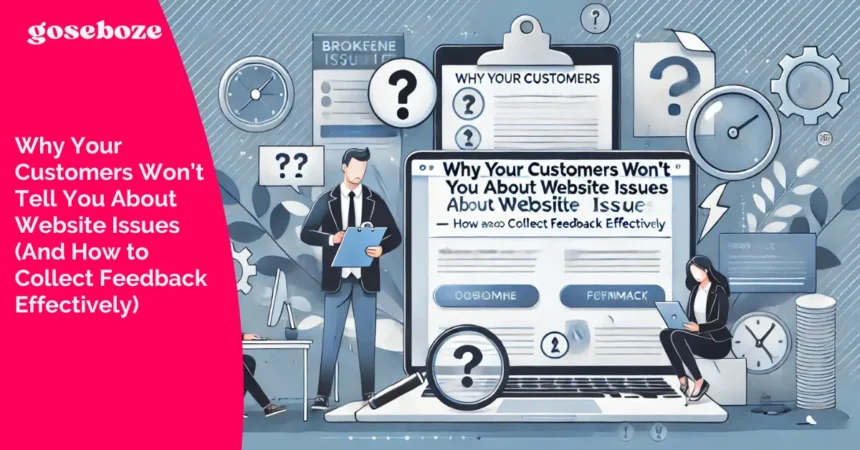Most businesses assume that if something is wrong with their website, customers will speak up. After all, why wouldn’t they? If a checkout button is broken or a form won’t submit, surely users would want to report the issue, right?
Unfortunately, that’s not how it works. The majority of users who run into website problems don’t take the time to complain—they simply leave. Research suggests that only 1 in 26 dissatisfied customers actually report an issue. The rest? They disappear, often never returning.
So why don’t customers speak up about website issues? And more importantly, how can businesses proactively collect feedback before losing valuable traffic and sales?
Why Customers Stay Silent About Website Problems
Understanding why users don’t report website issues is the first step to fixing them. Here are some of the most common reasons customers leave without saying a word:
1. They Don’t Have Time
People visit websites with a specific goal in mind—whether it’s making a purchase, reading content, or signing up for a service. If they hit a roadblock, most won’t take the extra step to report it. They’ll either refresh the page, try again later, or abandon the process altogether.
2. They Assume Someone Else Will Report It
Even if a user notices a bug, they often assume they’re not the only one experiencing it. They might think, The company probably already knows about this, and move on without saying anything.
3. They Don’t Know How to Report It
Many websites don’t provide an easy way for users to give feedback. If there’s no clear contact form, chat option, or reporting tool, customers won’t go out of their way to find one.
4. They Don’t Think It Will Make a Difference
If a customer has reported an issue in the past and never received a response or saw the problem fixed, they won’t bother reporting future issues. Users need to feel that their feedback matters, or they’ll keep their frustrations to themselves.
How to Collect Website Feedback Effectively
Since most users won’t voluntarily report issues, businesses need to take a proactive approach to collecting feedback. Here are some of the best ways to do it:
1. Make It Easy for Users to Report Issues
A simple feedback button placed in the corner of the website can make all the difference. Users should be able to report problems with minimal effort—no long forms, no searching for a contact page.
Website feedback tools allow users to highlight issues directly on the page they’re experiencing problems with. Some even let users attach screenshots or recordings, making it easier for teams to understand and fix the problem.
2. Use Session Replay Tools to See Issues Firsthand
Instead of relying solely on user reports, businesses can use session replay tools to watch real visitor interactions. These tools record user sessions, showing exactly where users struggle—whether it’s a broken link, an unclickable button, or a confusing navigation flow.
This eliminates the need for customers to explain issues themselves. If users keep abandoning a specific form, the recordings can reveal whether it’s due to a technical bug or poor design.
3. Encourage Feedback With Incentives
Sometimes, all it takes is a little encouragement. Offering a small discount, entry into a giveaway, or exclusive perks in exchange for feedback can increase participation.
While not every user will take the time to report issues, those who do will provide valuable insights that can help improve the site for everyone.
4. Explore Markup Alternatives for Internal Testing
Before issues reach customers, businesses should have an internal process for identifying and fixing them. Traditional email chains and spreadsheets can make bug reporting messy and inefficient. Instead, teams can explore markup alternatives that allow them to leave visual annotations directly on a website.
These tools streamline communication between designers, developers, and product managers, making it easier to track and resolve issues before they impact customers.
Read Also: Incorporating Inset Carousel Styles into Your Web
5. Follow Up on Reported Issues
If a user takes the time to report a problem, acknowledge it. Whether through an automated response or a personal follow-up, letting users know their feedback is valued increases the likelihood that they’ll report issues in the future.
Publicly sharing updates about bug fixes or website improvements can also show customers that their feedback is taken seriously.
Proactive Feedback Collection = Better User Experience
Relying on customers to report website issues is a risky strategy—most of them won’t. Instead, businesses should take the initiative by implementing easy-to-use feedback tools, analyzing user behavior, and optimizing internal bug tracking processes.
By creating a system that actively gathers insights, e-commerce businesses can identify and fix website problems before they drive customers away. In the end, a frictionless user experience doesn’t just keep visitors happy—it keeps them coming back.








